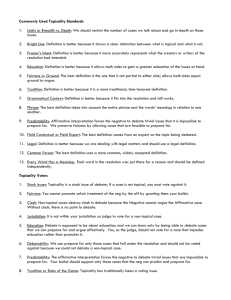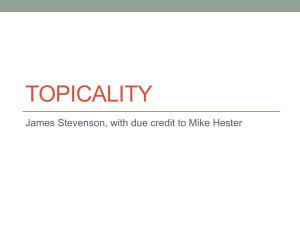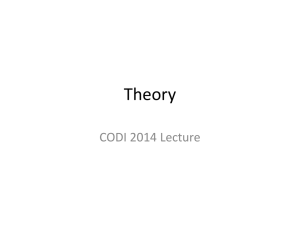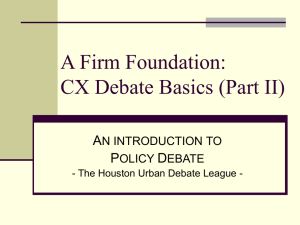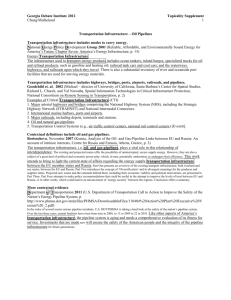Topicality - Kansas State University
advertisement
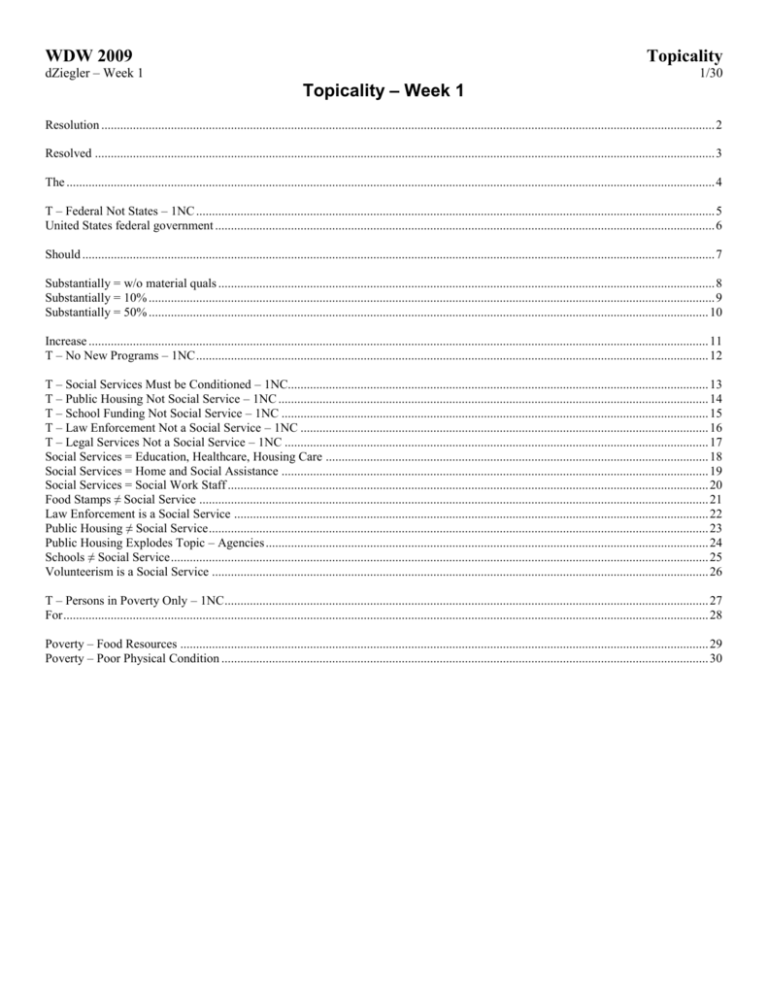
WDW 2009 Topicality dZiegler – Week 1 1/30 Topicality – Week 1 Resolution .................................................................................................................................................................................................. 2 Resolved .................................................................................................................................................................................................... 3 The ............................................................................................................................................................................................................. 4 T – Federal Not States – 1NC .................................................................................................................................................................... 5 United States federal government .............................................................................................................................................................. 6 Should ........................................................................................................................................................................................................ 7 Substantially = w/o material quals ............................................................................................................................................................. 8 Substantially = 10% ................................................................................................................................................................................... 9 Substantially = 50% ................................................................................................................................................................................. 10 Increase .................................................................................................................................................................................................... 11 T – No New Programs – 1NC .................................................................................................................................................................. 12 T – Social Services Must be Conditioned – 1NC..................................................................................................................................... 13 T – Public Housing Not Social Service – 1NC ........................................................................................................................................ 14 T – School Funding Not Social Service – 1NC ....................................................................................................................................... 15 T – Law Enforcement Not a Social Service – 1NC ................................................................................................................................. 16 T – Legal Services Not a Social Service – 1NC ...................................................................................................................................... 17 Social Services = Education, Healthcare, Housing Care ......................................................................................................................... 18 Social Services = Home and Social Assistance ....................................................................................................................................... 19 Social Services = Social Work Staff ........................................................................................................................................................ 20 Food Stamps ≠ Social Service ................................................................................................................................................................. 21 Law Enforcement is a Social Service ...................................................................................................................................................... 22 Public Housing ≠ Social Service .............................................................................................................................................................. 23 Public Housing Explodes Topic – Agencies ............................................................................................................................................ 24 Schools ≠ Social Service .......................................................................................................................................................................... 25 Volunteerism is a Social Service ............................................................................................................................................................. 26 T – Persons in Poverty Only – 1NC ......................................................................................................................................................... 27 For ............................................................................................................................................................................................................ 28 Poverty – Food Resources ....................................................................................................................................................................... 29 Poverty – Poor Physical Condition .......................................................................................................................................................... 30 WDW 2009 Topicality dZiegler – Week 1 2/30 *Resolution and Definitions* Resolved: The United States federal government should substantially increase social services for persons living in poverty in the United States. WDW 2009 Topicality dZiegler – Week 1 3/30 Resolved Resolved is to be firm. Mirriam Webster Online Dictionary, 2009, http://www.merriam-webster.com/dictionary/Resolved 5: to reach a firm decision about Resolved is a firm course of action. Oxford American Dictionary, 2005 Resolved – decide firmly on a course of action. WDW 2009 Topicality dZiegler – Week 1 4/30 The ‘The’ means all parts – specification is untopical. Merriam-Webster's Online Collegiate Dictionary, 2008, http://www.merriam-webster.com/dictionary/the 4 -- used as a function word before a noun or a substantivized adjective to indicate reference to a group as a whole <the elite> ‘The’ means something specific – the USfg and nothing else. American Heritage Dictionary of the English Language, 2000 (dictionary.com) the Used before singular or plural nouns and noun phrases that denote particular, specified persons or things: the baby; the dress I wore. Used before a noun, and generally stressed, to emphasize one of a group or type as the most outstanding or prominent: considered Lake Shore Drive to be the neighborhood to live in these days. Used to indicate uniqueness: the Prince of Wales; the moon. Used before nouns that designate natural phenomena or points of the compass: the weather; a wind from the south. Used as the equivalent of a possessive adjective before names of some parts of the body: grab him by the neck; an infection of the hand. Used before a noun specifying a field of endeavor: the law; the film industry; the stage. Used before a proper name, as of a monument or ship: the Alamo; the Titanic. Used before the plural form of a numeral denoting a specific decade of a century or of a life span: rural life in the Thirties. WDW 2009 Topicality dZiegler – Week 1 5/30 T – Federal Not States – 1NC A – Interpretation: 1 - “The” is used to denote a specific entity American Heritage, 00 (Fourth Edition, http://dictionary.reference.com/browse/the) the1 P (th before a vowel; th before a consonant) def.art. Used before singular or plural nouns and noun phrases that denote particular, specified persons or things: the baby; the dress I wore. 2 – Federal government is central government Webster’s New Intl Dictionary, 1976, p. lexis Federal government. Of or relating to the central government of a nation, having the character of a federation as distinguished from the governments of the constituent unites (as states or provinces). B – Violation – the plan acts through state governments, not the central government exclusively. C – Reasons to Prefer: 1 – Limits – opens up infinite interstate compacts, localized agreements, and county/city propositions we could never prepare for. 2 – Ground – key to all generics linked to federal action like politics and spending and States CP. 3 – It’s extra-topical – the resolution just says United States federal government – it’s an independent voter because it proves the resolution insufficient and explodes the topic with advantages we could never predict. D – T is a voter for competitive equity, fairness, and should be evaluated through competing interpretations. WDW 2009 Topicality dZiegler – Week 1 6/30 United States federal government Federal government is the national government that expresses power Black’s Law Dictionary, 8th Edition, June 1, 2004, pg.716. Federal government. 1. A national government that exercises some degree of control over smaller political units that have surrendered some degree of power in exchange for the right to participate in national politics matters – Also termed (in federal states) central government. 2. the U.S. government – Also termed national government. [Cases: United States -1 C.J.S. United States - - 2-3] Federal government is central government PRINCETON UNIVERSITY WORDNET, 1997, p. http://www.dictionary.com/search?q=federal%20government. Federal government. n: a government with strong central powers. The USfg is all 3 branches. Black’s Law Dictionary, 90 (6th Edition, p. 695) In the United States, government consists of the executive, legislative, and judicial branches in addition to administrative agencies. In a broader sense, includes the federal government and all its agencies and bureaus, state and county governments, and city and township governments. WDW 2009 Topicality dZiegler – Week 1 7/30 Should Should is a duty or obligation Webster's II, 1984, p. 1078 Should is used to express duty or obligation Should is equal to obligation WORDS AND PHRASES 1953, Vol. 39, p. 313. The word “should”, denotes an obligation in various degrees, usually milder than ought. Baldassarre v. West Oregon Lumber Co., 239 p.2d 839, 842, 198 Or. 556. WDW 2009 Topicality dZiegler – Week 1 8/30 Substantially = w/o material quals Substantially is without material qualification Black’s Law Dictionary 1991 [p. 1024] Substantially - means essentially; without material qualification. WDW 2009 Topicality dZiegler – Week 1 9/30 Substantially = 10% Substantially is 10% Justice McKelvie, 3-3-99 (United States District Court for the District of Delaware, 90 F. Supp. 2d 461; 1999 U.S. Dist. Lexis) Claim 1 of the '092 patent and claim 1 of the '948 patent contain the phrase "a die of substantially uniform cross-section." KXI contends the term "substantially" means "at least a 10% change in size." KXI contends that as applied to the claim, the phrase "substantially uniform cross-section" means "the die should not change in diameter by more than 10%." Culligan contends the phrase "substantially uniform cross-section" in the '092 and '948 patents means the internal cross-section of the die must vary less than about 0.010 inch along the length of the die. WDW 2009 Topicality dZiegler – Week 1 10/30 Substantially = 50% Substantially is at least 50%. Justice Selya, 5-25-2005 (United States Court of Appeals for the First Circuit, 408 F.3d 41; 2005 U.S. App. Lexis) For instance, the BAA permits the use of foreign goods if it is in the "public interest," 41 U.S.C. § 10d, and Law 109 does not contain such an exception. There are also disparities between the BAA and Law 109 as the former has been interpreted in federal regulations. One such disparity is that the preference for domestic construction materials in procurement by federal agencies is 6%, see 48 C.F.R. § 25.204(b), whereas the Preference Board currently sets the preference for purposes of Law 109 at 15%. Furthermore, the BAA requires contracts for construction of public buildings to favor items manufactured in the United States that are "substantially all" composed from American raw materials. 41 U.S.C. § 10b. The applicable federal regulation defines "substantially all" as meaning at least 50%. See 48 C.F.R. § 25.101(a)(2). In contradistinction, Law 109 seems to require that cement be manufactured 100% from indigenous (Puerto Rican) raw materials, save for those indigenous materials that are unavailable in commercial quantities. See 3 P.R. Laws Ann. § 927(d). WDW 2009 Topicality dZiegler – Week 1 11/30 Increase Increase is to make bigger. Oxford English Dictionary, March 2009 Increase – To become greater in size, amount, duration, or degree Increase is to enlarge. Oxford English Dictionary, March 2009 To enlarge WDW 2009 Topicality dZiegler – Week 1 12/30 T – No New Programs – 1NC A – Interpretation - Increase is to enlarge. Oxford English Dictionary, March 2009 Increase – To enlarge B – Violation – the aff creates a new social service program – they could have been topical by expanding a current program. C – Standards: 1 – Predictability – Infinite number of new programs we could never do sufficient research to prepare for. 2 – Resolutional focus – current conceptions of social services are premised on those currently existing – we allow the healthiest literature base. D – Topicality is a voter for competitive equity, fairness, and should be evaluated under competing interpretations. WDW 2009 Topicality dZiegler – Week 1 13/30 T – Social Services Must be Conditioned – 1NC A – Interpretation – Social Services must be conditioned upon an elimination of dependency. Justice Stewart, Director Dept of Public Aid of Illinois vs. Mandley, 1978 (436 US 725; 98 S. Ct. 2068, lexis) And the declared purpose of the new Title XX social services program enacted in 1975, 42 U. S. C. § 1397 et seq. (1970 ed., Supp. V), was to "[encourage] each State, as far as practicable under the conditions in that State, to furnish services directed at the goal of . . . achieving or maintaining economic self-support to prevent, reduce, or eliminate dependency. . . ." B – Violation – the aff doesn’t condition the social service on any move to self-sufficiency. C – Standards: 1 – Limits – there are an infinite number of unconditioned gifts we can give to poor people – there’s only a finite number of conditioned plans to do, which is key to pre-tournament preparation. 2 – Ground – explodes the number of services that can be given – justifies the “give money to x” demographic aff we could never have links to. 3 – Social services is a legislative term of art – this is the most real-world interpretation and what the literature is assuming. State of Michigan 2008 (Title XX Social Services Block Grant Plan, Department of Human Services, Admin for Budget, Analysis and Financial Management, p. http://www.michigan.gov/documents/dhs/DHS-SSBG-FY08-09_250475_7.pdf) Section 2006 of Title XX of the Social Security Act directs the Secretary to establish uniform definitions of services for use by the states in preparing the information to be submitted in the annual Social Services Block Grant report. These services are defined in title 45, part 96, appendix A of the code of federal regulations and are reflected in the state of Michigan's Title XX Social Services Block Grant Report. D – Topicality is a Voting issue for competitive equity, fairness, and should be evaluated through competing interpretations. WDW 2009 Topicality dZiegler – Week 1 14/30 T – Public Housing Not Social Service – 1NC A – Interpretation and violation – social services work to address limitations to self-sufficiency – while public housing is a conduit of this, it is not in itself a social service. Cassandra Netzke, Hamline J. of Public Law and Policy, Fall 2001 (“Current Public Law and Policy Issues: Rethinking Revitalization: Social Services in Segregation and Concentrations of Povery”, 23 Hamline J. Pub. L. & Pol’y 145, lexis) Future discussions of social services in a neighborhood must recognize the intimate relationship between those services and public housing. Two reasons in particular illustrate the need for this more comprehensive perspective. First, the effective administration of public housing is increasingly dependent upon the effective implementation of supportive social services. Secondly, the resulting collaborations between housing and social services directly impact the infrastructure and redevelopment of a community. For example, assume that the goals of public housing are to prevent homelessness and allow residents time to accumulate resources that will facilitate home ownership or moving into unsubsidized rental housing. Residents without job skills or food resources will most likely be unable to break the cycle of subsidization. Barriers to self-sufficiency, like chemical dependency or mental health issues, may make some residents dependent upon subsidized housing indefinitely. Until these barriers are addressed, and residents are empowered to control these obstacles, they may be unable to accumulate the necessary resources to move into unsubsidized housing. Hence, public housing may be able to prevent homelessness in some cases, but will not be able to transition residents into an unsubsidized housing situation. This is where social services, such as childcare or addiction counseling, come into play. B – Standards: 1 – Predictability – we can’t predict the infinite number of assistance programs that supplement social services. 2 – Ground – key to all of our disads linked to social service creation like spending, politics, and dependency. 3 – The aff is extra-topical by extending assistance outside of social services, which is an independent voter because it dejustifies the resolution and creates advantages we can’t predict. C – T is a voter for competitive equity, fairness, and should be evaluated through competing interpretations. WDW 2009 Topicality dZiegler – Week 1 15/30 T – School Funding Not Social Service – 1NC A – Interpretation – Social services are material support for personal community development – this is exclusive of aid to schools. Michele Estrin Gilman, Assistant Professor, University of Baltimore School of Law, April 2002, Vanderbilt Law Review, 55 Vand. L. Rev. 799 The term "social services" is usually defined in this country to mean "agencies that provide direct income and other material support, individual and family services, day care, residential care (except for nursing homes), job training, mental health and addiction services, nonhospital health care, as well as agencies that engage in community organizing, advocacy, or community development, including research and public education." Lester M. Salamon, Social Services, in Who Benefits from the Nonprofit Sector? 134, 136 (Charles T. Clotfelter ed., 1992). Hospitals, schools, and arts, culture, and recreation organizations are excluded from this definition. B – Violation – they increase school funding, not direct aid to those in poverty. C – Standards: 1 – Limits – they explode the topic by expanding funding for facilities that assist poor people, which is an extra-topical portion of the resolution we could never prepare for. 2 – Ground – we don’t get essential ground like the Dependency DA because they don’t give aid to people, but to organizations that assist those people. 3 – FX topicality is a voter because it justifies affs like “ban nuke war” that eventually help poor people but doesn’t allow us basic generic ground – we’d always lose. D – Topicality is a voting issue for competitive equity and fairness – it should be evaluated through competing interpretations. WDW 2009 Topicality dZiegler – Week 1 16/30 T – Law Enforcement Not a Social Service – 1NC A – Interpretation – Social services are financial assistance given through social work staff, not attorneys offices or law enforcement. Justice Raye, 8-26-1997, COURT OF APPEAL OF CALIFORNIA, THIRD APPELLATE DISTRICT, 57 Cal. App. 4th 784, *; 67 Cal. Rptr. 2d 350 Section 10051 states: " 'Public social services' means those activities and functions of state and local government administered or supervised by the department or the State Department of Health Services and involved in providing aid or services or both . . . to those people of the state who, because of their economic circumstances or social condition, are in need thereof and may benefit thereby." Section 10052 defines "aid" as "financial assistance provided to or in behalf of needy persons under the terms of this division, including direct money payments and vendor payments." The Department argues FSD provides parents with child support enforcement services, not financial assistance. We agree. FSD's activities do not constitute "aid" as defined by section 10052. Any payments recovered by FSD are not provided by the FSD but by the errant parent.Section 10053 defines "services" AS: "those activities and functions performed by social work staff and related personnel of the department and county departments with or in behalf of individuals or families, which are directed toward the improvement of the capabilities of such individuals or families maintaining or achieving a sound family life, rehabilitation, self-care, and economic independence."The Department argues child support services provided by the district attorney do not qualify as services under section 10053 because (1) they are not provided by social work staff and related personnel, but by attorneys, and (2) these attorneys are not "personnel of the department or county departments," but are personnel of the district attorney's office. We find the Department's argument persuasive. Section 10053 contemplates social services of a type performed by social workers, not collection services performed by legal personnel. As we discuss in greater detail, the family support division is not the "County Department" referred to in section 10053. The child support enforcement services offered by a district attorney are not "public social services" as the phrase is used in section 10950. To qualify as a public social service a state or local government function must constitute either "aid" or "services." Child support enforcement services provided by a district attorney are neither B – Violation – they don’t provide direct aid – they institute a program that solves social attributions that effect impoverished groups. C – Standards: 1 – Limits – they explode the topic by including discussions of solving social ills that hurt those in poverty – these are an infinite number of plans we could never predict. 2 – Ground – we lose core ground like the Dependency DA because they don’t actually give direct aid. 3 – Extra-topical because the aff gives something other than a social service – we can’t develop links to predictable aff arguments and it dejustifies the resolution – independent voter. D – Topicality is a voter for fairness and competitive equity. You should evaluate T through competing interpretations. WDW 2009 Topicality dZiegler – Week 1 17/30 T – Legal Services Not a Social Service – 1NC A – Interpretation – courts prove: legal services are a social service because they derive from the state attorney’s office, not social workers – social services must be from social workers. Justice Raye, 8-26-1997, COURT OF APPEAL OF CALIFORNIA, THIRD APPELLATE DISTRICT, 57 Cal. App. 4th 784, *; 67 Cal. Rptr. 2d 350 Section 10051 states: " 'Public social services' means those activities and functions of state and local government administered or supervised by the department or the State Department of Health Services and involved in providing aid or services or both . . . to those people of the state who, because of their economic circumstances or social condition, are in need thereof and may benefit thereby." Section 10052 defines "aid" as "financial assistance provided to or in behalf of needy persons under the terms of this division, including direct money payments and vendor payments." The Department argues FSD provides parents with child support enforcement services, not financial assistance. We agree. FSD's activities do not constitute "aid" as defined by section 10052. Any payments recovered by FSD are not provided by the FSD but by the errant parent.Section 10053 defines "services" AS: "those activities and functions performed by social work staff and related personnel of the department and county departments with or in behalf of individuals or families, which are directed toward the improvement of the capabilities of such individuals or families maintaining or achieving a sound family life, rehabilitation, self-care, and economic independence."The Department argues child support services provided by the district attorney do not qualify as services under section 10053 because (1) they are not provided by social work staff and related personnel, but by attorneys, and (2) these attorneys are not "personnel of the department or county departments," but are personnel of the district attorney's office. We find the Department's argument persuasive. Section 10053 contemplates social services of a type performed by social workers, not collection services performed by legal personnel. As we discuss in greater detail, the family support division is not the "County Department" referred to in section 10053. The child support enforcement services offered by a district attorney are not "public social services" as the phrase is used in section 10950. To qualify as a public social service a state or local government function must constitute either "aid" or "services." Child support enforcement services provided by a district attorney are neither B – Violation – the aff extends legal services – this is from attorney’s office, not social workers. C – Standards: 1 – Limits – they explode the topic by including legal mechanisms that go outside the discussion of providing legal services – we can’t predict those affs. 2 – Ground – we lose core ground like the Dependency DA because they don’t actually give direct aid. 3 – Extra-topical because the aff gives something other than a social service – we can’t develop links to predictable aff arguments and it dejustifies the resolution – independent voter. D – Topicality is a voter for competitive equity, fairness, and should be evaluated through competing interpretations. WDW 2009 Topicality dZiegler – Week 1 18/30 Social Services = Education, Healthcare, Housing Care Social services are government assistance in education, healthcare, and housing. Oxford English Dictionary, March 2009 A service provided or undertaken for the benefit of the community, esp. one provided by the state, as education, health care, housing, etc. WDW 2009 Topicality dZiegler – Week 1 19/30 Social Services = Home and Social Assistance Social services address home development and targeted assistance with known social problems. Cassandra Netzke, Hamline J. of Public Law and Policy, Fall 2001 (“Current Public Law and Policy Issues: Rethinking Revitalization: Social Services in Segregation and Concentrations of Povery”, 23 Hamline J. Pub. L. & Pol’y 145, lexis) According to the Southside Pride, there are approximately three hundred and sixty government, private, and quasi-private social services "operating or based in Phillips" as of May 2001. n64 Such organizations range from food shelves, homeless shelters, transitional living facilities, group homes, drug-rehab centers, job training, and affordable housing/home buying services. The Phillips Neighborhood Network (PNN) website lists social services in the community under the following headings: housing, safety, employment, health, youth, men's, and women's services. n65 In addition to agencies located directly in the neighborhood, PNN also provides listings of social services that are in close proximity to Phillips residents. n66 One such example is the African American Family Center, an agency that offers programs in employment, health, youth, men's, and women's services located less than a mile from Phillip's western border. n67 The agencies vary widely in character and range of services provided. For example, Lutheran Social Services offers various programs in health, employment, senior and youth services, touching on almost every aspect of social services that may be required by families. n68 The American Indian Aids Task Force, in [*155] contrast, serves a narrowly tailored purpose. There is no specific report that examines the amount of duplicated services by these agencies, though the repetition of agency names throughout the categories of services is noticeable. n69 For the purposes of this article, there are two significant categories of social services. The first is the public/private partnership that is responsible for development plans, particularly in the area of housing and transportation in Phillips, such as the Phillips Partnership and Project for Pride in Living (PPL). n70 These organizations, composed primarily of private businesses and developers sanctioned by public agencies, have influence over development issues critical to livability in Phillips. n71 These organizations must fall under scrutiny in this debate because of their unfettered influence over the character of the community without adequate representation of the interests of community residents. n72 The second category covers agencies that satisfy the more traditional sense of social services. These services are primarily created to address specific social concerns in target populations. n73 They may focus on particular ethnic and racial groups and often compete for the same public grants in addition to offering overlapping services. In turn, their valuable role in the community has the negative consequence of using limited infrastructure and funding resources that draw away from planning and revitalization programs that could facilitate desegregation. These organizations are necessary and improve the lives of community members, but need not be entirely concentrated in the Phillips neighborhood. Their services can be distributed more effectively throughout the [*156] city to address service needs on a larger geographic scale and assist deconcentration efforts. WDW 2009 Topicality dZiegler – Week 1 20/30 Social Services = Social Work Staff Social services are financial assistance given through social work staff. Justice Raye, 8-26-1997, COURT OF APPEAL OF CALIFORNIA, THIRD APPELLATE DISTRICT, 57 Cal. App. 4th 784, *; 67 Cal. Rptr. 2d 350 Section 10051 states: " 'Public social services' means those activities and functions of state and local government administered or supervised by the department or the State Department of Health Services and involved in providing aid or services or both . . . to those people of the state who, because of their economic circumstances or social condition, are in need thereof and may benefit thereby." Section 10052 defines "aid" as "financial assistance provided to or in behalf of needy persons under the terms of this division, including direct money payments and vendor payments." The Department argues FSD provides parents with child support enforcement services, not financial assistance. We agree. FSD's activities do not constitute "aid" as defined by section 10052. Any payments recovered by FSD are not provided by the FSD but by the errant parent.Section 10053 defines "services" AS: "those activities and functions performed by social work staff and related personnel of the department and county departments with or in behalf of individuals or families, which are directed toward the improvement of the capabilities of such individuals or families maintaining or achieving a sound family life, rehabilitation, self-care, and economic independence."The Department argues child support services provided by the district attorney do not qualify as services under section 10053 because (1) they are not provided by social work staff and related personnel, but by attorneys, and (2) these attorneys are not "personnel of the department or county departments," but are personnel of the district attorney's office. We find the Department's argument persuasive. Section 10053 contemplates social services of a type performed by social workers, not collection services performed by legal personnel. As we discuss in greater detail, the family support division is not the "County Department" referred to in section 10053. The child support enforcement services offered by a district attorney are not "public social services" as the phrase is used in section 10950. To qualify as a public social service a state or local government function must constitute either "aid" or "services." Child support enforcement services provided by a district attorney are neither WDW 2009 Topicality dZiegler – Week 1 21/30 Food Stamps ≠ Social Service Food stamps are public assistance, not a social service – Courts have deemed. Justice Kirshbaum, 1985 (Supreme Court of Colorado, 697 P.2 d 1; 1985 Colo, lexis) The Department, created by § 24-1-120, 10 C.R.S. (1982), is authorized to administer "programs relating to public assistance and welfare." § 26-1-102(1), 11 C.R.S. (1982). The Code at times implies that the term "social services" is an all encompassing generic term ("In providing for such programs relating to public assistance and welfare, the General Assembly finds that recipients of social services qualify . . . . for such services . . . . The state department, not the several county governments, is the principal in all federal-state social services programs covered in this title . . . ." § 26-1-102(2), 11 C.R.S. (1982)). However, the term "social services" is specifically defined as "services and payments for services . . . . available . . . . through the social services staff of the state and county departments for the benefit of eligible persons . . . ." Id. § 26-2-103(11). The term "public assistance" is more broadly defined to include "assistance payments, food stamps, and social services provided to or on behalf of eligible recipients . . . ." Id. § 26-2-103(7). Furthermore, the Department's administrative authority is defined as authority "to administer or supervise the administration of public assistance programs" and to "establish public assistance programs consisting of assistance payments and social services . . . ." Id. § 26-2-104. Provisions describing the Department's authority to comply with applicable federal requirements, § 26-2-105, and describing procedures for initiating applications for public assistance, § 26-2-106, also suggest that the term "public assistance" is the more inclusive phrase. We will use the term "public assistance" to include all forms of payments and services authorized by the Code WDW 2009 Topicality dZiegler – Week 1 22/30 Law Enforcement is a Social Service Social services includes law enforcement. Jay T. Jorgensen, 1997, Brigham Young University Law Review, 1997 B.Y.U.L. Rev. 899 Unless indicated otherwise, this Comment will use the phrases "social services" or "services" to include educational services, cash payment and in-kind welfare programs, and law enforcement and correctional systems, including incarceration and parole. WDW 2009 Topicality dZiegler – Week 1 23/30 Public Housing ≠ Social Service Social services address personal limitations to self-sufficiency, such as chemical dependency and fixed costs. Public housing itself is not a social service because it does not facilitate self-sufficiency. Cassandra Netzke, Hamline J. of Public Law and Policy, Fall 2001 (“Current Public Law and Policy Issues: Rethinking Revitalization: Social Services in Segregation and Concentrations of Povery”, 23 Hamline J. Pub. L. & Pol’y 145, lexis) Future discussions of social services in a neighborhood must recognize the intimate relationship between those services and public housing. Two reasons in particular illustrate the need for this more comprehensive perspective. First, the effective administration of public housing is increasingly dependent upon the effective implementation of supportive social services. Secondly, the resulting collaborations between housing and social services directly impact the infrastructure and redevelopment of a community. For example, assume that the goals of public housing are to prevent homelessness and allow residents time to accumulate resources that will facilitate home ownership or moving into unsubsidized rental housing. Residents without job skills or food resources will most likely be unable to break the cycle of subsidization. Barriers to self-sufficiency, like chemical dependency or mental health issues, may make some residents dependent upon subsidized housing indefinitely. Until these barriers are addressed, and residents are empowered to control these obstacles, they may be unable to accumulate the necessary resources to move into unsubsidized housing. Hence, public housing may be able to prevent homelessness in some cases, but will not be able to transition residents into an unsubsidized housing situation. This is where social services, such as childcare or addiction counseling, come into play. WDW 2009 Topicality dZiegler – Week 1 24/30 Public Housing Explodes Topic – Agencies Public housing explodes the topic – use of NGO’s and private developers make the function of implementation almost unpredictable. Cassandra Netzke, Hamline J. of Public Law and Policy, Fall 2001 (“Current Public Law and Policy Issues: Rethinking Revitalization: Social Services in Segregation and Concentrations of Povery”, 23 Hamline J. Pub. L. & Pol’y 145, lexis) The second consideration speaks directly to the impact on a community resulting from social service and housing collaborations. This situation will be illustrated in further detail, but is generally most problematic when government defers to private developers and non-governmental organizations to create [*157] joint housing and support service developments. n74 Such projects imbue non-governmental organizations with responsibility not just for support services but also for urban planning projects with far reaching impact on the rest of the community. n75 Legitimate concerns about representation and adequate consideration of overall development needs in a community are brought to the forefront when private interests are given such discretion. n76 WDW 2009 Topicality dZiegler – Week 1 25/30 Schools ≠ Social Service Social services are material support for personal community development – this is exclusive of aid to schools. Michele Estrin Gilman, Assistant Professor, University of Baltimore School of Law, April 2002, Vanderbilt Law Review, 55 Vand. L. Rev. 799 The term "social services" is usually defined in this country to mean "agencies that provide direct income and other material support, individual and family services, day care, residential care (except for nursing homes), job training, mental health and addiction services, nonhospital health care, as well as agencies that engage in community organizing, advocacy, or community development, including research and public education." Lester M. Salamon, Social Services, in Who Benefits from the Nonprofit Sector? 134, 136 (Charles T. Clotfelter ed., 1992). Hospitals, schools, and arts, culture, and recreation organizations are excluded from this definition. WDW 2009 Topicality dZiegler – Week 1 26/30 Volunteerism is a Social Service Volunteerism is a social service. Oxford English Dictionary, March 2009 Service to society or for the benefit of other people, esp. philanthropic work on behalf of the poor or underprivileged. WDW 2009 Topicality dZiegler – Week 1 27/30 T – Persons in Poverty Only – 1NC A – Interpretation: 1 – For indicates the subject of the resolution – social services – relates to the object of the resolution – persons in poverty. Oxford English Dictionary, March 2009 For – Indicating the object to which the activity of the faculties or feelings is directed 2 – Increase means persons in poverty have to be the recipient of the social service Oxford English Dictionary, March 2009 For – Introducing the intended recipient, or the thing to which something is intended to belong, or in connexion with which it is to be used B – Violation – the affirmative extends a social service to more than just those in poverty. C – Standards: 1 – Extra-topical – they go outside the boundaries of the resolution. This is bad: A – Ground – we can’t claim essential disad and link arguments to affs outside the bounds B – Proves the topic insufficient – independent reason to vote aff C – Predictability – can’t never develop ground against advantages we couldn’t predict in the resolution. 2 – Infinitely Regressive – any act that stops a bad social occurrence could potentially affect those in poverty – justifies affs like “Ban nuke war” and “Ban racism” that we could never defeat. D – Topicality is a voting issue for competitive equity and fairness, and should be evaluated through competing interpretations. WDW 2009 Topicality dZiegler – Week 1 28/30 For For indicates the subject of the resolution – social services – relates to the object of the resolution – persons in poverty. Oxford English Dictionary, March 2009 For – Indicating the object to which the activity of the faculties or feelings is directed Increase means persons in poverty have to be the recipient of the social service Oxford English Dictionary, March 2009 For – Introducing the intended recipient, or the thing to which something is intended to belong, or in connexion with which it is to be used WDW 2009 Topicality dZiegler – Week 1 29/30 Poverty – Food Resources Living in poverty means to have less than 3 times the bread basket Anne K. Driscoll, Institute for Health Policy Studies, School of Medicine @ UC San Francisco, 2002 (Journal of Social Policy, Poverty and Welfare Patterns: Implications for Children, lexis) In the UK and other European countries, living in poverty is commonly defined as having half of the national median household income. In the USA, living in poverty is defined as having an income that is three times the low cost food budget, a definition that is controversial but which has been consistently tracked over many decades. However, both the UK and the USA have higher rates of poverty among children than other industrialized European nations. Declining but large proportions of American children are in poverty and/or receive welfare. During the 1970s, the proportion of American children living in poverty rose substantially from 14.9 per cent in 1970 to 19.5 per cent in 1980. Since then, the percentage of poor children in the USA has hovered between 17 and 22 per cent; in 1999, 16.9 per cent of children were living in poverty. Although poverty is defined differently in the USA than in the UK, approximately one-third of children in the UK were living in poverty in 1996 WDW 2009 Topicality dZiegler – Week 1 30/30 Poverty – Poor Physical Condition Living in poverty includes bad physical conditions or nourishment. Oxford English Dictionary, March 2009 Poor physical condition; leanness or feebleness resulting from insufficient nourishment
